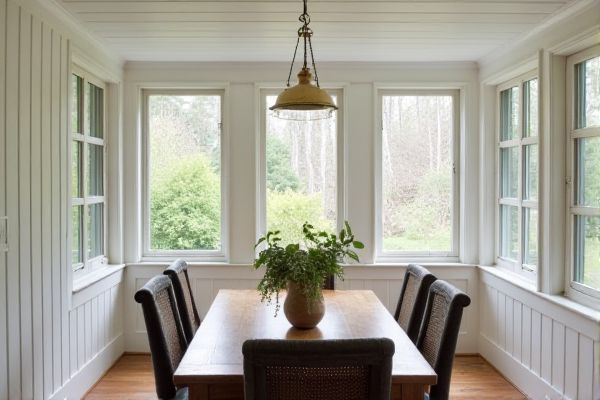
Shiplap offers a sleek, horizontal plank design that creates a modern, seamless look ideal for sunroom walls, while beadboard features narrow, vertical grooves that add classic charm and texture to the space. Explore the differences to determine which wall treatment best suits Your sunroom's style and ambiance in the rest of this article.
Table of Comparison
| Feature | Shiplap | Beadboard |
|---|---|---|
| Material | Wood or MDF panels with rabbeted edges | Wood or MDF panels with vertical grooves |
| Appearance | Horizontal, clean lines; rustic to modern | Vertical grooves; traditional, cottage style |
| Installation | Overlapping boards; easy to install | Panels or strips; requires precise alignment |
| Durability | Durable if sealed; resistant to moisture | Durable; may require more maintenance in humid areas |
| Cost | Moderate to high | Moderate |
| Style Compatibility | Modern, farmhouse, coastal | Traditional, cottage, vintage |
| Maintenance | Occasional repainting or sealing | Regular cleaning; touch-ups for grooves |
Introduction to Sunroom Wall Options
Shiplap and beadboard are popular wall options for sunrooms, each offering distinct aesthetic and functional benefits. Shiplap features wide, flat boards with recessed joints that create a sleek, modern look while providing durability and easy maintenance. Beadboard consists of narrow planks with a beaded groove, delivering a classic, textured appearance that enhances the cozy and traditional charm of sunroom interiors.
What is Shiplap?
Shiplap is a type of wooden board commonly used for interior walls, featuring rabbeted edges that create a tight, overlapping joint for a smooth, uniform appearance. Its wide, horizontal planks offer a modern farmhouse aesthetic while providing durability and ease of installation, particularly suitable for sunroom walls exposed to varying humidity. The recessed grooves between boards enhance ventilation and add depth, making shiplap an attractive alternative to beadboard for contemporary and rustic sunroom designs.
What is Beadboard?
Beadboard is a type of paneling featuring narrow, vertical planks separated by distinctive grooves or "beads," often made from wood or MDF. This material enhances sunroom walls with a classic cottage or farmhouse aesthetic while providing durability and ease of installation. Its moisture-resistant properties make beadboard ideal for humid environments like sunrooms, compared to traditional shiplap, which consists of horizontally overlapping boards.
Shiplap Sunroom Walls: Pros and Cons
Shiplap sunroom walls provide a sleek, horizontal plank design that enhances a modern farmhouse aesthetic while ensuring durable, weather-resistant surfaces ideal for sunroom environments. The gaps between the boards allow for natural expansion and contraction, preventing warping, but may require regular sealing to maintain moisture resistance. However, installation can be more labor-intensive compared to beadboard, and the linear style may not suit all interior designs.
Beadboard Sunroom Walls: Pros and Cons
Beadboard sunroom walls provide a classic, textured appearance that enhances farmhouse or cottage-style aesthetics while offering durability and easy maintenance due to their moisture-resistant properties. They can be more susceptible to dirt accumulation in grooves and may require regular cleaning to maintain their crisp, detailed lines. Installation can be time-consuming compared to shiplap, but beadboard's ability to hide minor wall imperfections makes it a favorable option for sunrooms exposed to varying weather conditions.
Aesthetic Differences: Shiplap vs. Beadboard
Shiplap sunroom walls offer a sleek, horizontal panel design that creates a modern, streamlined aesthetic with visible grooves between each board, enhancing visual depth. In contrast, beadboard features narrow, vertical planks with distinctive bead-like grooves that evoke a classic, cottage-style charm, adding texture and character to the space. Choosing between shiplap and beadboard affects not only the room's visual appeal but also how light interacts with the wall surfaces, influencing the overall ambiance.
Durability and Maintenance Comparison
Shiplap sunroom walls offer superior durability due to their thicker, overlapping boards that resist moisture and warping better than beadboard's thinner panels, which can be more prone to dents and cracks. Maintenance for shiplap typically requires less frequent repainting or sealing, making it ideal for areas exposed to humidity or sunlight. Your choice depends on whether you prioritize long-lasting resilience with lower upkeep or a more decorative, traditional look that may need occasional repair.
Installation Process: Shiplap vs. Beadboard
Shiplap installation involves tongue-and-groove boards that interlock horizontally, providing a tight, seamless fit that resists drafts and moisture, ideal for sunroom walls. Beadboard requires aligning narrow vertical panels or planks with distinctive grooves and beads, typically secured with nails or adhesive, offering a more textured, traditional look. Both materials demand careful measurement and level alignment, but shiplap generally allows faster installation due to its overlapping design, while beadboard requires more precision to maintain uniform bead spacing and joint consistency.
Cost Comparison: Shiplap vs. Beadboard for Sunrooms
Shiplap typically costs between $3 to $8 per square foot, offering a more affordable option for sunroom walls compared to beadboard, which ranges from $5 to $10 per square foot. Labor expenses for installing shiplap tend to be lower due to its wider boards and simpler installation process, while beadboard requires precise alignment and more detailed work, increasing labor costs. Material durability and maintenance needs also influence the overall expense, with shiplap generally demanding less upkeep in high-moisture sunroom environments versus the more delicate beadboard.
Choosing the Right Wall Style for Your Sunroom
When choosing the right wall style for your sunroom, consider that shiplap offers a clean, horizontal plank look with tight seams ideal for a modern or farmhouse aesthetic, while beadboard features narrow vertical grooves adding texture and a classic, cottage charm. Shiplap's durability and moisture resistance make it suitable for sunrooms exposed to varying weather conditions, whereas beadboard provides a visually detailed surface that can brighten your space with a traditional feel. Your decision should balance the desired architectural style with maintenance preferences and environmental exposure to ensure lasting beauty and functionality.
 homyna.com
homyna.com